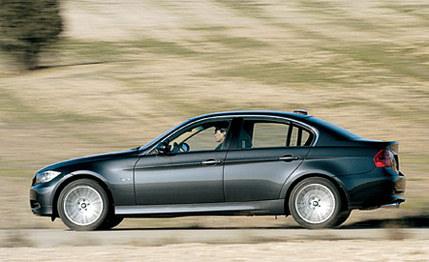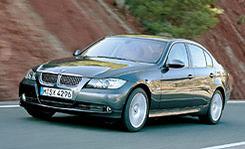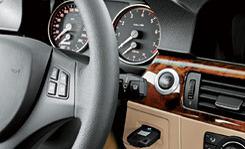 Road Test
Road Test
To be writing about a new BMW without first questioning the way it looks is a welcome change from recent history. The design revolution of BMW's Chris Bangle has polarized opinion on everything from the blocky 7-series to the banana-curved 1-series. But for the company's most important model, there is a comfortable familiarity, a gentle evolution.
The 3-series, 30 years old and now entering its fifth generation, is the car that made BMW what it is today The bestselling premium model worldwide, it accounts for some 60 percent of the one million new cars BMW sells each year. The message to the anarchic Bangle was: Don't mess with the DNA of the goose that laid the golden egg.
Most buyers will recognize the new car as a 3-series, even with the curvier elements of the 5-series around the front and an interior theme that also mimics its bigger brother. They'll be pleased by the improvement in this model's already superlative mechanicals and driving behavior. Which is good news because, appearance aside, a year ago we were not convinced the current 5-series was a major advance over its predecessor.
The new 330i sedan, the only version coming to the U.S. that was available at the preview, has the latest lightweight 3.0-liter straight-six engine with variable valve timing and lift (see Technical Highlights). With 255 horsepower, it's 13 percent more powerful and likely more fuel efficient. (This Valvetronic engine will soon be fitted to the 530i.) So this top-of-the-line 3-series is quicker and more economical than before. All 3s carry six-speed gearboxes, manual or automatic, that work beautifully.
The platform is new but the layout is familiar—struts at the front and a multilink rear suspension. But for the first time on the 3-series, the struts now employ the double-pivot lower arm long used on larger BMWs. And the multilink rear uses five elements rather than four to provide better wheel control while retaining sufficient compliance for a soft ride. Most of these new components are hewed from aluminum to minimize weight.
 As with most new models, the 3-series has grown a bit. It's 2.2 inches longer on a wheelbase extended by 1.4 inches, and width is up by 3.0 inches, although half of that increase is caused by protruding door handles. Accordingly, the new sedan, known internally as the E90, is about 150 pounds heavier than its E46 predecessor, yet it retains BMW's typical nearly 50/50 front-to-rear weight distribution. The handling balance we have always admired in the 3-series remains one of its most enjoyable features.
As with most new models, the 3-series has grown a bit. It's 2.2 inches longer on a wheelbase extended by 1.4 inches, and width is up by 3.0 inches, although half of that increase is caused by protruding door handles. Accordingly, the new sedan, known internally as the E90, is about 150 pounds heavier than its E46 predecessor, yet it retains BMW's typical nearly 50/50 front-to-rear weight distribution. The handling balance we have always admired in the 3-series remains one of its most enjoyable features.
Run-flat tires are used with every tire-and-wheel option on the new 3-series. We haven't liked the ride quality of run-flats specified for other BMWs, but the 3-series engineers say they were better able to tune the suspension to match these tires because there is no conventional alternative. The 330i models we drove had the standard suspension shod with Pirelli Eufori@
run-flats and did seem more comfortable over broken road surfaces than 5-series cars of our experience.
 You do have a choice about the active steering system, introduced in the latest 5-series and available as an option for the new 3. A variable steering ratio, more direct (10.8:1) at low speed for agility and less so (up to 18.0:1) at high speed for straight-line stability, feels more intuitive in this car than it does in the 5 and has the advantage of providing a small amount of automatic opposite lock when the electronics detect that the car is oversteering. That said, we are still not entirely convinced it is better to drive than the regular linear power steering we tried in a Euro-spec 320d diesel.
You do have a choice about the active steering system, introduced in the latest 5-series and available as an option for the new 3. A variable steering ratio, more direct (10.8:1) at low speed for agility and less so (up to 18.0:1) at high speed for straight-line stability, feels more intuitive in this car than it does in the 5 and has the advantage of providing a small amount of automatic opposite lock when the electronics detect that the car is oversteering. That said, we are still not entirely convinced it is better to drive than the regular linear power steering we tried in a Euro-spec 320d diesel.
A workout on an artificially slippery handling track did prove the value of DSC+, BMW's latest electronic stability-control system that is standard on the 330i. As in the previous model, the traction-control element has two modes. Press the button marked (confusingly) DTC, and it allows a fair degree of sliding before working its magic with the throttle and brakes at individual wheels. That threshold is nicely judged and entertaining for the enthusiast; a five-second push on the button turns off the traction and stability controls completely, but you probably wouldn't want to do that except on a dry racetrack.